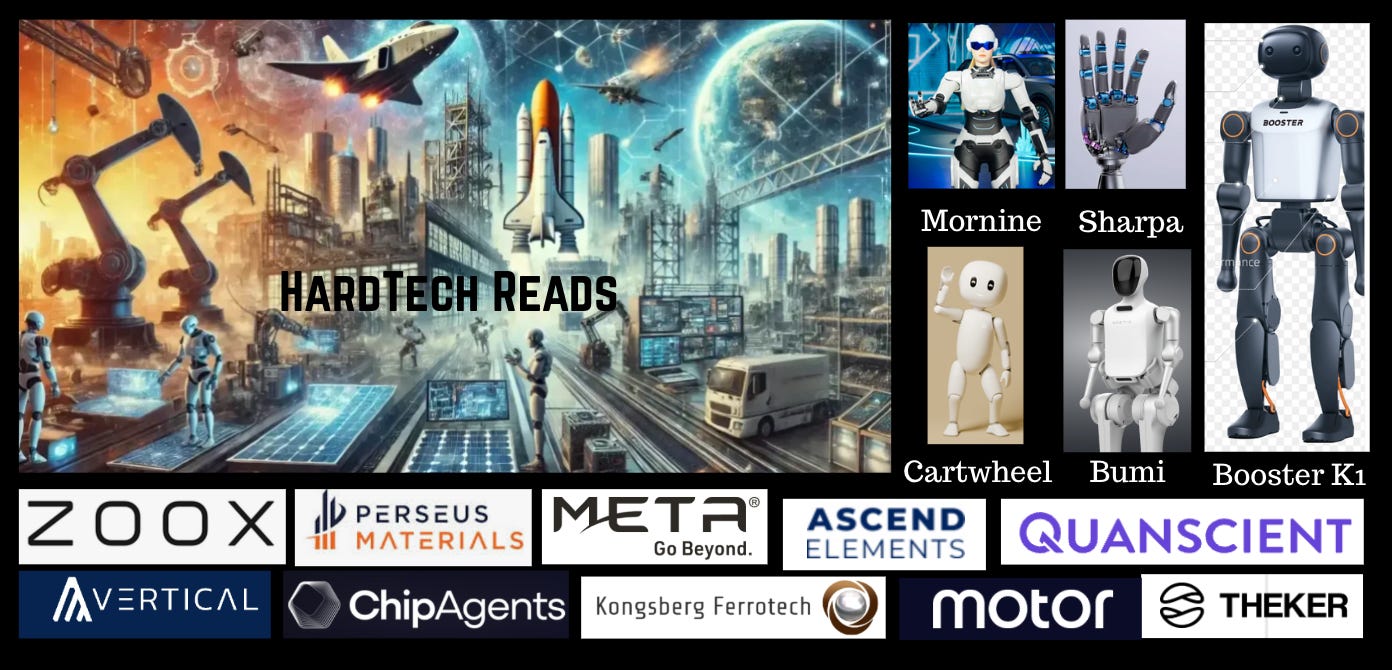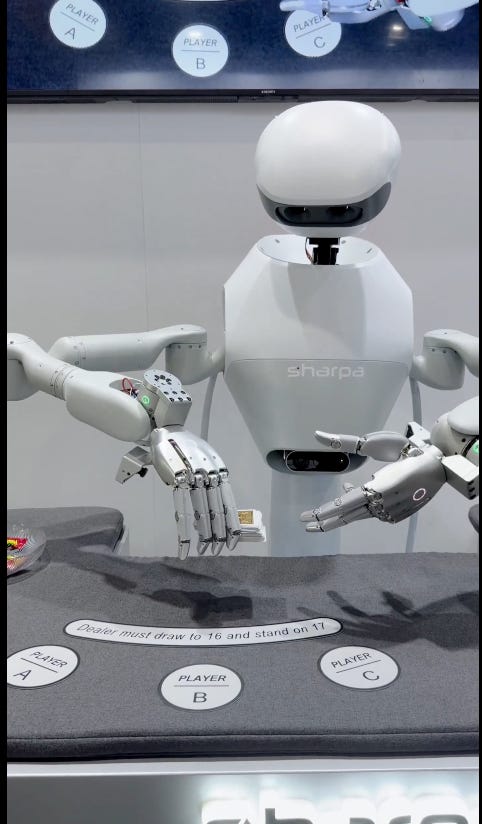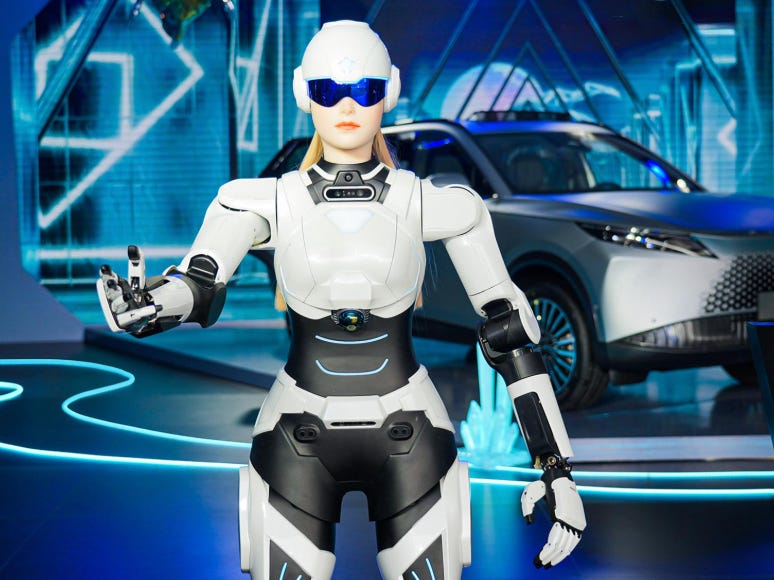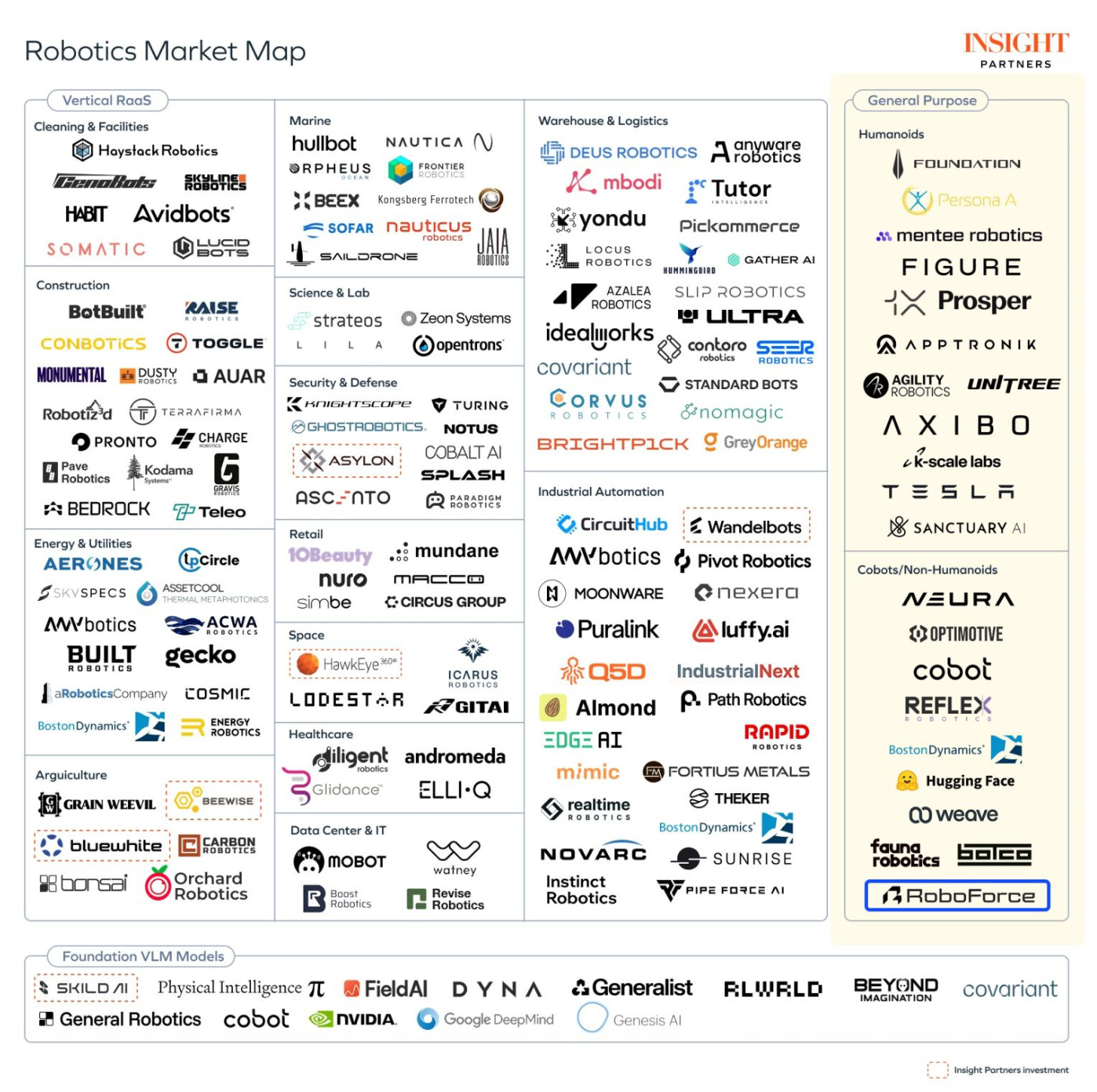🦾 HardTech Reads: The AI & Robotics Revolution vol.53
Welcome to the exploration of the world where founders embark on bold quests and solve non-obvious problems🤘
What’s in today?
🚀 HARDTECH NEWS: Robotics & AI Innovations
🔬 STARTUPS FUNDING: Game-Changers in HardTech & AI
👨🔧 HARDTECH STARTUPS ARE HIRING
📚 FAVORITE RESOURCES
💃 EVENTS
🚀 HARDTECH NEWS: Robotics & AI Innovations
🤖 $1,400 humanoid Bumi, 🖐️ Sharpa’s 22-DOF robotic hand, 🤸 Cartwheel Robotics’ Yogi humanoid, 🚗 Chery’s Mornine showroom humanoid, 🎓 Booster K1 educational humanoid, 📦 Amazon’s 500K warehouse automation plan, 🌊 Kongsberg underwater repair robots, 🏭 THEKER’s vision-adaptive warehouse arm, 💰 JPMorgan’s $1.5T industrial investment, 🚌 MOTOR Ai’s autonomous transit platform, 🛒 Telexistence’s Manila-piloted shelf robots, 🚕 Zoox tests in Washington DC, 🤔 Rodney Brooks on humanoid bubble, 🏗️ Perseus Materials’ infinite composites.
🤖 Chinese Noetix Launches $1,400 Humanoid Robot
Noetix Robotics has launched Bumi, an affordable humanoid robot priced at just $1,400 USD (9,998 RMB). Standing at 0.94 meters and weighing 12 kg, Bumi features 21 degrees of freedom for versatile movement capabilities. The ultra-low price point represents a dramatic shift in humanoid robotics accessibility, potentially democratizing robot development and education.
While specifications are modest compared to industrial humanoids, Bumi’s affordability could accelerate experimentation and adoption in research institutions, universities, and hobbyist communities worldwide.
🖐️ Sharpa Robotics Unveils SharpaWave: 22-DOF Robotic Hand with 1,000+ Tactile Pixels
Singapore-based Sharpa Robotics has launched SharpaWave, a life-size robotic hand representing a significant leap in dexterous manipulation technology. The system features 22 degrees of freedom for human-like movement, over 1,000 tactile pixels per fingertip, and 0.005 N pressure sensitivity. Demonstrated capabilities range from delicate tasks like egg handling to complex operations including piano playing and precision cutting.
This technology bridges the gap between strength, speed, and fine motor control — a combination that has long challenged robotics development. The implications for manufacturing, healthcare, and collaborative robotics applications are substantial as the industry moves toward human-level dexterity.
New China AI Robots SHOCK The World
Acting Human, Artificial Astronauts, Robotic Birth and many more! Check the video!
🤸 Cartwheel Robotics Reveals Yogi: Next-Gen Humanoid with Soft Skin and AI Motion Control
Cartwheel Robotics has revealed Yogi, a next-generation humanoid robot designed to fit naturally into human environments like homes, hospitals, and hotels. Yogi features soft silicone skin, human-friendly proportions, and AI-driven motion control that allows it to move fluidly and safely around people.
It’s powered by a proprietary full-stack humanoid system with custom hardware, modular batteries, and a motion language model that turns voice or text commands into lifelike gestures. Founded by Scott LaValley, a former Boston Dynamics and Disney Imagineering engineer, Cartwheel Robotics is focused on creating humanoids people genuinely connect with. The company will debut Yogi’s full walking prototype at the Humanoids Summit in December, followed by deployments in hospitals, hotels, and research facilities in 2026.
🚗 Chinese Automaker Chery Unveils Mornine Humanoid for Showroom Customer Service
Chinese automaker Chery has introduced Mornine, a humanoid robot developed by its robotics arm AiMOGA Robotics to act as an intelligent customer assistant in showrooms and promotional events.
The robot made its debut at the 2025 Chery International User Summit in Wuhu, China, where it performed live demonstrations including greeting guests, giving product introductions, and explaining vehicle functions. Chery says the robot integrates AI large-model technology with gesture recognition and multimodal interaction, enabling lifelike conversations in multiple languages. AiMOGA Robotics describes Mornine as a service-oriented humanoid designed to enhance human-machine communication in retail environments, representing the automotive industry’s push into robotics beyond manufacturing.
🎓 Booster Robotics K1 Brings Affordable Humanoid Robots to K-12 Education
Booster Robotics launched the K1 humanoid robot designed specifically for educational environments and children. The fully-assembled, portable robot walks, balances, and interacts in real-time using depth cameras and motion sensors, priced at roughly the cost of a high-end laptop.
This move democratizes access to robotics education and suggests the emerging humanoid robotics market is rapidly expanding beyond industrial and commercial applications into consumer and educational segments. The K1 enables hands-on learning in STEM curricula, giving students direct experience with humanoid control systems, computer vision, and autonomous navigation.
📦 Amazon Plans to Automate 75% of Warehouse Operations, Potentially Replacing 500K+ Workers by 2033? (Don’t be fooled!)
According to internal documents, Amazon plans to automate up to 75% of its warehouse operations, replacing more than half a million jobs with robots by 2033. The company’s automation strategy spans six categories — movement, manipulation, sorting, storage, identification, and packing — enabling employees to touch products at only a few stages in the most advanced facilities while saving 30 cents per delivery item. This represents one of the largest planned workforce transformations in corporate history, with profound implications for labor markets, logistics economics, and the future of warehouse work. The initiative underscores Amazon’s commitment to robotics as a competitive advantage in e-commerce fulfillment.
🌊 Kongsberg Ferrotech Launches NATO-Backed Underwater Robots for Critical Infrastructure Repair
Norwegian Kongsberg Ferrotech secured €12M Series A led by the NATO Innovation Fund for autonomous underwater robots inspecting and repairing offshore pipelines, power cables, and fiber optic infrastructure. Already working with industry giants Aramco, Petrobras, and Total Energies, the platform addresses rising threats to subsea cables from geopolitical tensions and natural hazards. The NATO backing signals strategic recognition that underwater infrastructure protection is critical to national security, particularly as subsea cable sabotage has emerged as a geopolitical flashpoint. The technology enables rapid response to infrastructure damage without requiring specialized human divers.
🏭 THEKER Robotics Launches Next-Gen Warehouse Arm with Autonomous Vision Adaptation
Barcelona-based THEKER Robotics raised €18M led by Kibo Ventures for its AI-powered robotic arm featuring integrated deep learning vision and autonomous task adaptation. The system handles automated picking, packing, food processing, and waste sorting with fast customer acquisition — notably backed by Inditex (Zara’s parent company) — marking serious commercial traction in warehouse automation. The autonomous vision adaptation allows the arm to handle previously unseen objects without manual reprogramming, a critical capability for dynamic warehouse environments where product SKUs constantly change.
💰 JPMorgan Announces $1.5 Trillion Industrial Investment to Supercharge American Manufacturing
JPMorganChase has launched a 10-year, $1.5 trillion initiative to invest in industries deemed critical to the country’s defense, infrastructure and technological advancement as part of efforts to strengthen U.S. economic and national security. The financial services firm said the Security and Resiliency Initiative will make direct equity and venture capital investments of up to $10 billion in U.S.-based companies to advance strategic manufacturing and drive innovation and growth. This represents one of the largest private-sector commitments to American industrial policy, signaling a fundamental shift in capital allocation toward reshoring and supply chain resilience.
🚌 MOTOR Ai Deploys Cognitive AI Platform for Autonomous Transit Systems Across Germany
Berlin-based MOTOR Ai closed €17.1M Series A co-led by Segenia Capital and eCAPITAL to scale its explainable AI for autonomous buses and shuttles. The platform handles untested scenarios critical to European safety regulations, and already secured official autonomous vehicle testing permits for road traffic across multiple German districts — proving real-world deployment readiness. The explainable AI approach addresses regulatory requirements that autonomous systems must provide transparent reasoning for safety-critical decisions, a key barrier to autonomous transit deployment in Europe.
🛒 Teleoperated Robots Transform Tokyo Retail as Remote Hands from Manila Drive Automation
Telexistence’s shelf-stocking robots deployed across 300+ Japanese convenience stores are now piloted by remote operators in the Philippines via VR interfaces. When robots encounter edge cases — dropped items, misaligned placements — Manila-based pilots intervene teleoperationally, with each correction training autonomous systems for future independence. This hybrid model demonstrates how teleoperation captures embodied labor data while offshoring repetitive work globally. The approach represents a pragmatic path to autonomy: human teleoperation handles exceptions while simultaneously generating training data to eliminate those exceptions over time.
🤖 Amazon Robotics’ ViTa-Zero Solves Zero-Shot Visuotactile Challenge
Amazon Robotics has developed ViTa-Zero, a breakthrough system that combines visual and tactile sensing to enable robots to manipulate previously unseen objects without prior training. The zero-shot visuotactile approach represents a significant advance in robotic perception, allowing warehouse robots to handle novel items reliably on first encounter. This capability is critical for e-commerce fulfillment where product variety is vast and constantly changing, making it impractical to pre-train robots on every possible item.
🚕 Zoox Begins Testing Autonomous Vehicles in Washington, D.C.
Amazon-owned Zoox has begun testing its purpose-built autonomous vehicles in Washington, D.C., expanding beyond its initial deployment cities. The nation’s capital presents unique challenges including complex traffic patterns, diplomatic motorcades, and dense pedestrian activity around government buildings. Successful operation in D.C. would demonstrate Zoox’s capability to handle some of the most demanding urban environments in the United States, potentially opening pathways to broader East Coast deployment.
🏗️ Perseus Materials Enables Infinitely Long Composite Manufacturing
Perseus Materials in Knoxville has developed a breakthrough machine that creates infinitely long objects like wind turbine blades and bridge components through continuous composite curing and shaping. The proprietary manufacturing process represents a major advance in composite production, addressing a key bottleneck in renewable energy and infrastructure. Traditional composite manufacturing is limited by mold size and autoclave dimensions, but Perseus’s continuous process eliminates these constraints. This technology could transform how large-scale composite structures are manufactured at scale, enabling longer wind turbine blades for greater energy capture and more efficient infrastructure components.
🤔 Rodney Brooks: Current Humanoid Funding Boom is a Bubble
Famed roboticist Rodney Brooks, co-founder of iRobot and Rethink Robotics, believes the current humanoid funding boom is a bubble due to fundamental hardware shortcomings. Yes, we need more contrarian views to challenge the accumptions and idealistic views. Brooks argues that despite massive investment, humanoid robots still lack the reliability, dexterity, and cost-effectiveness required for widespread commercial deployment. His skepticism carries weight given his decades of experience building commercial robots, and serves as a counterpoint to the current wave of optimism surrounding humanoid development. The debate highlights ongoing tensions between ambitious visions for general-purpose humanoids and the practical engineering challenges that remain unsolved.
🤖 Agility Robotics Expands Humanoid Production in Oregon
Agility Robotics announced an expansion of its Salem, Oregon factory to scale production of its Digit humanoid robot, targeting commercial deliveries to logistics partners in 2026. The facility now includes an AI-driven testing line for motion calibration and reliability optimization. The expansion signals Agility’s transition from R&D to manufacturing scale-up, with the company positioning Digit for deployment in warehouse and logistics applications where labor shortages and repetitive tasks create strong economic incentives for automation.
🔬 STARTUPS FUNDING: Game-Changers in HardTech & AI
➡️ Figure AI raised $720M Series B led by Microsoft, OpenAI Startup Fund, and NVIDIA, with participation from Parkway Ventures and ARK Invest. Funds will accelerate humanoid robot assembly line automation and power system manufacturing, positioning Figure as a leader in commercial humanoid deployment.
➡️ Quanscient secured $5.3M seed round led by Maki.vc and Superhero Capital. The Finnish startup combines quantum computing and multiphysics simulation for hardware design optimization in superconducting and plasma systems, addressing computational bottlenecks in advanced physics engineering.
➡️ Meta Materials Inc. received $12M grant from the Canadian government to scale roll-to-roll production of optical metamaterials used in sensors and defense coatings. The funds support expansion of its Nova Scotia nanofabrication facility.
➡️ Ascend Elements closed a $540M Series D extension led by Decarbonization Partners (BlackRock × Temasek), with new capital from Samsung Venture Investment. Funding supports battery-cathode manufacturing using recycled lithium-ion feedstock, addressing critical material supply chains for EV batteries.
➡️ Vertical Semiconductor raised $11M seed led by Playground Global, with participation from JIMCO Technology Ventures, milemark•capital, and Shin-Etsu Chemical. The MIT spinout is developing vertical gallium nitride (GaN) transistors for next-generation power delivery systems, building on a decade of research from MIT’s Palacios Group.
➡️ ChipAgents closed a $21M Series A led by Bessemer Venture Partners, bringing total funding to $24M. The round includes participation from semiconductor leaders Micron Ventures, MediaTek, and Ericsson, validating the company’s AI-powered approach to accelerating semiconductor design cycles and reducing time-to-production for next-generation chips.
➡️ Kongsberg Ferrotech secured €12M Series A led by the NATO Innovation Fund for autonomous underwater robots inspecting and repairing offshore infrastructure.
➡️ THEKER Robotics raised €18M led by Kibo Ventures for AI-powered robotic arms with autonomous vision adaptation, backed by Inditex (Zara’s parent company).
➡️ MOTOR Ai closed €17.1M Series A co-led by Segenia Capital and eCAPITAL to scale explainable AI for autonomous buses and shuttles across Germany.
👉 Feature your company in HardTech Reads
📚FAVORITE RESOURCES
➡️Humanoids Are Not Beating The (Hype Cycle) Allegations
Industrial humanoid robotic developers saw 17 fundraising rounds in Q3, more than any other market and good for a back-to-back quarterly record (with 23 deals in Q2).
➡️100 Steps to Build a Humanoid Robot: Clear overview of the 100-step construction process with highlights of famous robot analysis including Tesla and Boston Dynamics systems. 👉 Get the guide
👨🔧 HARDTECH STARTUPS ARE HIRING
‼️The coolest jobs this week:
🔥 Platform Engineer $160K-$300K
➡️ Test TechnicianNew at Figure
➡️ Data Scientist (SF), $130K-$300K
🔥 Founding Engineers at Icon
➡️ Mechanical Engineer / Remote
🔥 Chief of Staff at GPTZero
🔥 Support Engineer at Greptile
🔥 Software Engineer (Generalist) at Greptile
🔥 Product Engineer at Moment
🔥 Head of Marketing at Magna
🔥Distributed Systems Engineer at Moment
🔥Robotic Operations Technician at Figure
🔥Test TechnicianNew at Figure
🎤EVENTS - Let’s meet up!
🦿 Oct 23 — WERC Texas Warehousing Forum (Grapevine, TX)
🇸🇬 Oct 27–29 — ROSCon (Singapore)
🌍 Oct 19–25 — IEEE IROS(Hangzhou, China)
🔧 Oct 29 — Hard Tech Summit (Ontario, Canada)
🤠 Nov 3–5 — Intl. Robot Safety Conference (Houston, TX)
🇯🇵 Dec 1–4 — Intl. Conference on Space Robotics (Sendai, Japan)
🇦🇪 Dec 8–12 — Deep Tech Week Dubai 2025
🦿 Dec 11–12 — Humanoid Summit (Silicon Valley, TBA)- — ping me if you are there
🇬🇧 Mar 16–19, 2026 — Intl. Conference on Human-Robot Interaction (Edinburgh, Scotland)
🤝 Passionate about HardTech?
Have comments, want to share some thoughts or ask about sponsorships?
👉 Send me a note:
👉 Feature your company in HardTech Reads:
Check my previous posts:
➡️The Physical AI Revolution: Mapping the $60 Trillion Transformation
❗️The VC Industry Loves Data. But Doesn’t Use It…
— Is it why it’s ‘dying’?
➡️19 Robotic Hands Startups to Watch
➡️ The world doesn’t fix itself. These startups are trying /Top 100 HardTech Startups
➡️ Will we have a chatGPT moment for Robots?
➡️ The Coming Scarcity of Humanity
➡️ The Art and Science of Venture Capital Investing
➡️ Deep Thinkers & Builders in Tech, Science and Bio
➡️ Humanoids Don’t Exist in Isolation / It Takes an Ecosystem to Bring Them to Life!
➡️ Clone Alpha: The Next Leap in Humanoid Robotics
➡️ ‘Made in China’-Robotics Market Overview
➡️ The Science of Networks: From Theory to New Realities









